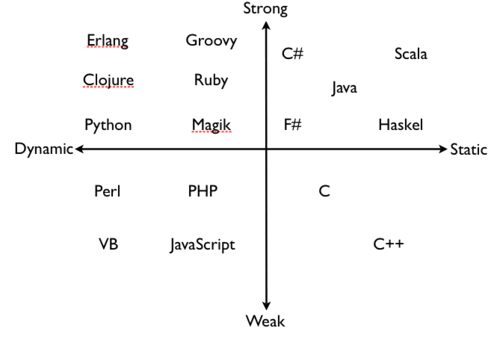转载: https://www.zhihu.com/question/19918532
弱类型:
> "1"+2 '12'
强类型:
>>> "1"+2 Traceback (most recent call last): File "<stdin>", line 1, in <module> TypeError: cannot concatenate 'str' and 'int' objects
动态类型:
>>> a = 1 >>> type(a) <type 'int'> >>> a = "s" >>> type(a) <type 'str'>
静态类型:
Prelude> let a = "123" :: Int
<interactive>:2:9:
Couldn't match expected type `Int' with actual type `[Char]'
In the expression: "123" :: Int
In an equation for `a': a = "123" :: Int





 本文通过示例介绍了弱类型、强类型、动态类型和静态类型的特性。弱类型语言中不同类型的数据可以混合运算;强类型语言则不允许不同数据类型的混合运算;动态类型语言变量的类型在运行时确定;静态类型语言变量的类型在编译时确定。
本文通过示例介绍了弱类型、强类型、动态类型和静态类型的特性。弱类型语言中不同类型的数据可以混合运算;强类型语言则不允许不同数据类型的混合运算;动态类型语言变量的类型在运行时确定;静态类型语言变量的类型在编译时确定。
















 894
894

 被折叠的 条评论
为什么被折叠?
被折叠的 条评论
为什么被折叠?








